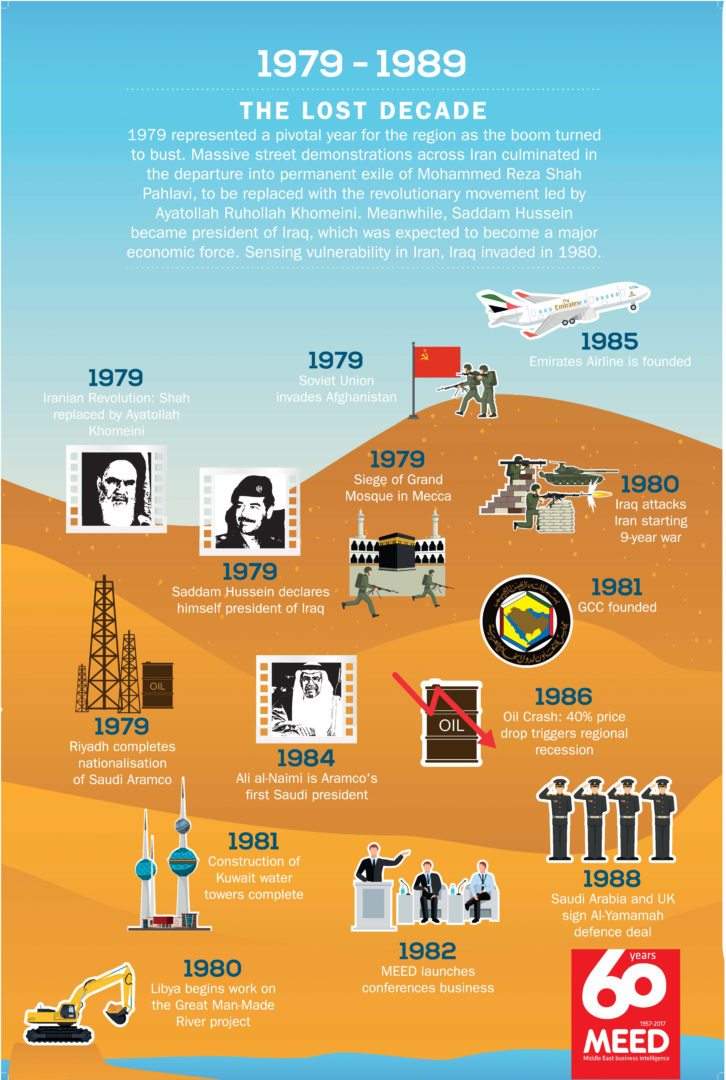

1979 represented a turning point for the region as the boom turned to bust. Massive street demonstrations across Iran culminated in the departure into permanent exile of Mohammed Reza Shah Pahlavi, to be replaced with the revolutionary movement led by Ayatollah Ruhollah Khomeini. Meanwhile, Saddam Hussein became president of Iraq, which was expected to become a major economic force. Sensing vulnerability in Iran, Iraq invaded in 1980

MEED 1979-1989 infographic
MEED 1979-1989 infographic
Flush with oil revenues, the region seemed set for a golden period as the 1980s dawned. But the conflicts that would define the decade were soon evident.
In the final week of 1979, the USSR invaded Afghanistan. The malaise spread as the revolutionary government in Iran struggled to consolidate its authority. In early 1980, violent clashes started with Iraq.
Reviled following the seizure of the US embassy in 1979, Iran looked vulnerable. On 22 September, Iraqs President Saddam Hussein ordered an invasion of the Iranian oil province of Khuzestan. It quickly became clear the war would be a long and damaging affair.
Drawn together by the Iran challenge, the six states of the Arabian Peninsula formed the GCC in 1981.
Oil prices reached record levels in the winter of 1980 despite Saudi Arabia pushing its production to capacity. This saw a huge rise in export earnings.
10 April 1963
Egypt, Syria and Iraq agree to form United Arab Republic
30 April 1976
UAEs first oil refinery opened by President Sheikh Zayed
9 April 1988
Hijacked Kuwait plane lands in Mashhad with three members of Kuwaits ruling family on board
10 April 1998
Abu Dhabi receives bids for Taweelah A2, the UAEs first independent water and power project
9 April 1999
Investors await approval of new law creating UAE stock exchange
9 April 2003
US troops symbolically topple giant statue of Iraqs deposed president Saddam Hussein in Baghdad
The region faced a new blow in 1982, when Israel invaded Lebanon. Beirut was occupied, the Palestine Liberation Organization (PLO) was expelled and Lebanon disintegrated.
Nevertheless, economic development across the region reached a crescendo. New industries founded in the 1970s entered production. Defence spending started to quicken.
Once it became clear Opecs aggressive price policy was resulting in a loss of market share, output was cut to support prices, leaving exporters with huge fiscal deficits.
In the summer of 1985, Saudi Arabia, by then producing less oil than the UK, was facing a current account deficit of more than $20bn. In 1985, Opec abandoned its price defence strategy to chase market share and by mid-1986, oil prices had fallen to below $10 a barrel.
Political events compounded the regions economic problems. South Yemen erupted into conflict in early 1986. The same year, Iran captured the Fao Peninsula. US bombers attacked Tripoli. Kuwaits assembly was suspended and militias battled for control of Lebanon.
In 1988, the Soviets announced they would withdraw from Afghanistan; Iran accepted a UN-sponsored ceasefire; the PLO declared it was ready to come to terms with Israel; and peace in Lebanon was heralded by the 1989 Taif agreement.
But this was a false dawn. By late 1989, it was evident Iraq was seeking drastic solutions to its economic problems.
You might also like...

Hassan Allam and Siemens confirm Hafeet Rail award
24 April 2024

UAE builds its downstream and chemical sectors
24 April 2024

Acwa Power eyes selective asset sales
24 April 2024

Bahrain mall to install solar carport
24 April 2024
A MEED Subscription...
Subscribe or upgrade your current MEED.com package to support your strategic planning with the MENA region’s best source of business information. Proceed to our online shop below to find out more about the features in each package.







